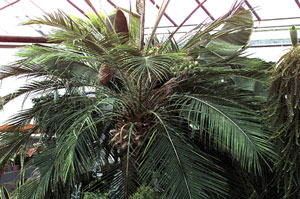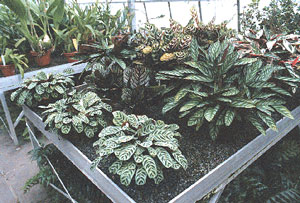Subclass Arecidae
Subclass Arecidae is relatively small with about 5600 species, but many of its members are familiar, eg. palm trees, or exotic-leaved houseplants belonging to the aroid family.
 Arecaceae: Palm family
Arecaceae: Palm family
Palm fossils date back to the Upper Cretaceous period (80 Myr). Palms are unusual among monocots in having broad leaves and an arborescent (tree) habit (though without secondary growth). They are not deciduous and the vast majority are limited to tropical regions. Palms bear large inflorescences of small flowers near the top of the plant.
Right: Phoenix dactylifera is the date palm, of ancient cultivation in the desert belt of N Africa and the Middle East. Palm trees bear fruit from 5-7 years old. The world population of date palms is about 93 million trees. For many Arab peoples, the date is the staple carbohydrate food. The earliest date stones are from Ancient Egypt about 4500 B.C. The date palm is dioecious, i.e. with separate male and female trees. Date palm plantations have one male to 25-50 females and pollination is carried out manually or by machines. Artificial pollination is mentioned in cuneform texts from Ur (2300 B.C.).
Araceae: Aroid family
 Most aroids are herbs of the tropical or subtropical forest floor, but they are familiar as colourful leafy houseplants. There are many aroids in the Tropical Glasshouse (left). See the Araceae page for more about Aroids.
Most aroids are herbs of the tropical or subtropical forest floor, but they are familiar as colourful leafy houseplants. There are many aroids in the Tropical Glasshouse (left). See the Araceae page for more about Aroids.
